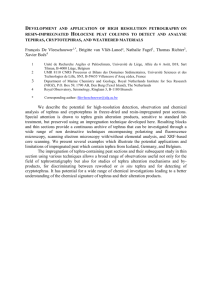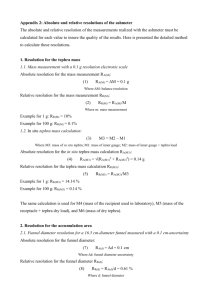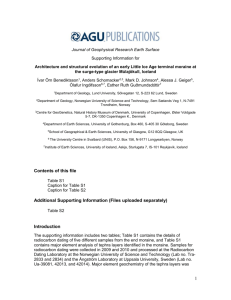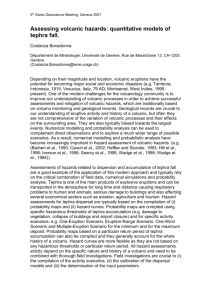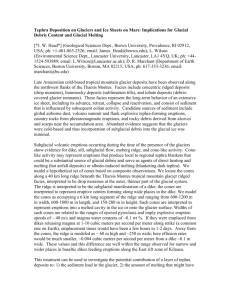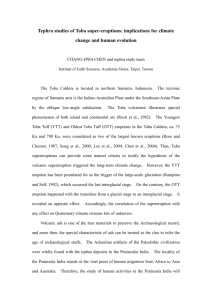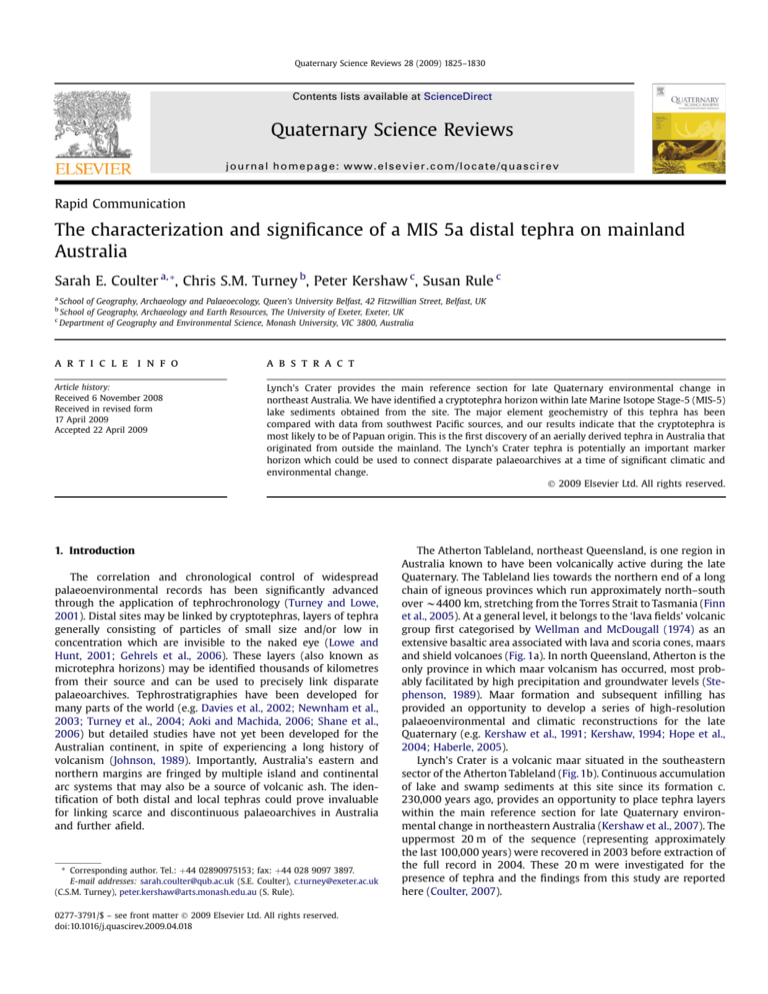
Quaternary Science Reviews 28 (2009) 1825–1830
Contents lists available at ScienceDirect
Quaternary Science Reviews
journal homepage: www.elsevier.com/locate/quascirev
Rapid Communication
The characterization and significance of a MIS 5a distal tephra on mainland
Australia
Sarah E. Coulter a, *, Chris S.M. Turney b, Peter Kershaw c, Susan Rule c
a
School of Geography, Archaeology and Palaeoecology, Queen’s University Belfast, 42 Fitzwillian Street, Belfast, UK
School of Geography, Archaeology and Earth Resources, The University of Exeter, Exeter, UK
c
Department of Geography and Environmental Science, Monash University, VIC 3800, Australia
b
a r t i c l e i n f o
a b s t r a c t
Article history:
Received 6 November 2008
Received in revised form
17 April 2009
Accepted 22 April 2009
Lynch’s Crater provides the main reference section for late Quaternary environmental change in
northeast Australia. We have identified a cryptotephra horizon within late Marine Isotope Stage-5 (MIS-5)
lake sediments obtained from the site. The major element geochemistry of this tephra has been
compared with data from southwest Pacific sources, and our results indicate that the cryptotephra is
most likely to be of Papuan origin. This is the first discovery of an aerially derived tephra in Australia that
originated from outside the mainland. The Lynch’s Crater tephra is potentially an important marker
horizon which could be used to connect disparate palaeoarchives at a time of significant climatic and
environmental change.
Ó 2009 Elsevier Ltd. All rights reserved.
1. Introduction
The correlation and chronological control of widespread
palaeoenvironmental records has been significantly advanced
through the application of tephrochronology (Turney and Lowe,
2001). Distal sites may be linked by cryptotephras, layers of tephra
generally consisting of particles of small size and/or low in
concentration which are invisible to the naked eye (Lowe and
Hunt, 2001; Gehrels et al., 2006). These layers (also known as
microtephra horizons) may be identified thousands of kilometres
from their source and can be used to precisely link disparate
palaeoarchives. Tephrostratigraphies have been developed for
many parts of the world (e.g. Davies et al., 2002; Newnham et al.,
2003; Turney et al., 2004; Aoki and Machida, 2006; Shane et al.,
2006) but detailed studies have not yet been developed for the
Australian continent, in spite of experiencing a long history of
volcanism (Johnson, 1989). Importantly, Australia’s eastern and
northern margins are fringed by multiple island and continental
arc systems that may also be a source of volcanic ash. The identification of both distal and local tephras could prove invaluable
for linking scarce and discontinuous palaeoarchives in Australia
and further afield.
* Corresponding author. Tel.: þ44 02890975153; fax: þ44 028 9097 3897.
E-mail addresses: sarah.coulter@qub.ac.uk (S.E. Coulter), c.turney@exeter.ac.uk
(C.S.M. Turney), peter.kershaw@arts.monash.edu.au (S. Rule).
0277-3791/$ – see front matter Ó 2009 Elsevier Ltd. All rights reserved.
doi:10.1016/j.quascirev.2009.04.018
The Atherton Tableland, northeast Queensland, is one region in
Australia known to have been volcanically active during the late
Quaternary. The Tableland lies towards the northern end of a long
chain of igneous provinces which run approximately north–south
over w4400 km, stretching from the Torres Strait to Tasmania (Finn
et al., 2005). At a general level, it belongs to the ‘lava fields’ volcanic
group first categorised by Wellman and McDougall (1974) as an
extensive basaltic area associated with lava and scoria cones, maars
and shield volcanoes (Fig. 1a). In north Queensland, Atherton is the
only province in which maar volcanism has occurred, most probably facilitated by high precipitation and groundwater levels (Stephenson, 1989). Maar formation and subsequent infilling has
provided an opportunity to develop a series of high-resolution
palaeoenvironmental and climatic reconstructions for the late
Quaternary (e.g. Kershaw et al., 1991; Kershaw, 1994; Hope et al.,
2004; Haberle, 2005).
Lynch’s Crater is a volcanic maar situated in the southeastern
sector of the Atherton Tableland (Fig. 1b). Continuous accumulation
of lake and swamp sediments at this site since its formation c.
230,000 years ago, provides an opportunity to place tephra layers
within the main reference section for late Quaternary environmental change in northeastern Australia (Kershaw et al., 2007). The
uppermost 20 m of the sequence (representing approximately
the last 100,000 years) were recovered in 2003 before extraction of
the full record in 2004. These 20 m were investigated for the
presence of tephra and the findings from this study are reported
here (Coulter, 2007).
1826
S.E. Coulter et al. / Quaternary Science Reviews 28 (2009) 1825–1830
Fig. 1. (a) Northeast Queensland Lava Field provinces, from Stephenson et al. (1980) reproduced with permission of the Geological Society of Australia, Queensland Division; (b) the
location of Lynch’s Crater on the Atherton Tableland, Australia.
2. Lynch’s Crater and the regional setting
Lynch’s Crater (17 370 S, 145 700 E) is located in the wet tropics of
Australia at an altitude of 760 m above sea level (Fig. 1b) and experiences a rainfall of about 2500 mm/a and a mean annual temperature
of w20.4 C (Busby, 1991). It is approximately circular in shape with
a maximum width of w850 m. The region lies at the southern limit of
summer monsoon penetration across northern Australia, experiencing both northwesterly and southeast trade winds (Kershaw,
1994). North–south trending mountain ranges border the western
and eastern margins of the Atherton Tableland which is situated on
a steep precipitation gradient; rainfall varies from 4000 mm/a at the
coast to 1500 mm/a between 20 and 60 km inland (Kershaw et al.,
1993). The region is drained by the Baron, Mulgrave and Russell rivers,
which discharge into the Coral Sea (Kershaw et al., 1993).
In 2004, funding from The National Geographic allowed drilling
of the complete sedimentary sequence, providing the opportunity
to undertake a comprehensive multi-proxy analysis. A full pollen
record is now available for this 64 m long archive (Kershaw et al.,
2007) and has been placed within an age model constructed
through correlation to the SPECMAP marine isotope stratigraphy
(Martinson et al., 1987) and ODP site-820 from the adjacent Coral
Sea (Peerdeman et al., 1993; Moss and Kershaw, 2000).
then prepared for geochemical analysis using the acid digestion
method described by Dugmore et al. (1995) followed by flotation
and alkali treatment using 10% KOH (Rose et al., 1996).
Tephra-rich samples were embedded in araldite, course-ground
and polished using 12 mm aluminium oxide powder and 1 mm
diamond paste, respectively. Tephra major element concentrations
were analysed on the Cameca SX-100 electron microprobe at the
Tephrochronology Analytical Unit, University of Edinburgh. Two
operating conditions were applied during wavelength dispersive
analysis: (1) 15 kV, 5 nA, 5 mm beam diameter; and (2) 10 kV, 10 nA
and 5 mm beam diameter. Due to the scarcity of glass shards
recovered, their size and vesicle-rich nature, analyses with totals
>94% were accepted.
4. Results and discussion
Few shards were recorded through most of the sequence but
significant quantities of tephra were found at 1877 cm (w60 shards
per cm3 of wet sediment) and 1899 cm (w53 shards per cm3 of wet
sediment). The tephra horizon at 1877 cm (henceforth described as
LY 1877) consisted of small (40–60 mm), clear-pink tephra shards
with exceptionally thin walls and prominent vesicles. Unfortunately, there were insufficient shards within the 1899 cm horizon
for geochemical characterization.
3. Materials and methods
4.1. LY 1877 tephra age determination
A truck-mounted drill rig was used to extract a 20 m core from
a central location within Lynch’s Crater in 2003. The following
treatments were used to concentrate tephra contained within the
cored sediments for optical identification: loss-on-ignition, 10% HCl
digestion and sieving. The residues were placed on a glass slide and
analysed under an optical microscope at 400 magnification. Glass
shards were found within the older sediments at 1876–1880 cm
and 1899–1903 cm. Flotation, using sodium polytungstate with
a density of 2.25 g/cm3 (Eden et al., 1992; Turney, 1998; Blockley
et al., 2005), was used to remove high concentrations of biogenic
silica in the flot and help to isolate the shards in these sections.
Samples of peak concentration within a single centimetre were
An approximate age for the LY 1877 tephra was estimated
through comparison with the age model developed by Kershaw
et al. (2007) for the complete sequence (Fig. 2). Loss-on-ignition
profiles for both records were found to be identical. The tephra is
located just below the transition between MIS-5 and -4, marked by
a decrease in precipitation inferred from the dryland pollen
signature and sediment stratigraphy, which shows a shift from lake
sediments to swamp conditions (Kershaw et al., 2007). Lake levels
appear to have fallen at this time and swamp conditions became reestablished; the inwash of inorganic sediment into the lake centre
was significantly reduced. This transition is found at w17.4 m in the
S.E. Coulter et al. / Quaternary Science Reviews 28 (2009) 1825–1830
1827
Fig. 2. (a) Stratigraphy and Loss-on-Ignition for the Lynch’s Crater 20 m core; (b) Loss-on-Ignition and age model for the 64 m core (Kershaw et al., 2007).
20 m core and at w23 m in the 64 m core (Fig. 2). A tentative
correlation between the two records suggests an age of between
75,000 and 90,000 years for the LY 1877 tephra (Coulter, 2007). A
MIS-5a age is demonstrated for pollen samples within this part of
the sequence by a distinctive assemblage that includes high values
for rainforest taxa such as Oraniopsis and Dacrydium in combination
with low sclerophyll representation. Together these indicate
rainfall as high as that in the present interglacial but temperatures
that were several degrees lower than today.
4.2. Geochemistry and source of the Lynch’s Crater tephra
Geochemical analyses on single glass shards from LY 1877 are
presented in Table 1. This tephra has a rhyolitic composition and
Table 1
Major element compositional data (un-normalized) expressed as weight % for (a) twelve analyses on eight individual glass shards within sample LY 1877. Standard analyses are
reported in Appendix 1. (b) tephra bed 311.2 from the New Ireland basin (Horz et al., 2004). Total iron is calculated as FeO. (c) Cameca SX-100 electron microprobe conditions
used during analysis of LY 1877 single glass shards.
a
LY 1877
SiO2
Al2O3
TiO2
FeO
MnO
MgO
CaO
Na2O
K2O
P2O5
Total
A
B
C
D
E
F
G
H
I
J
K
L
Mean
73.92
73.55
74.21
74.21
74.42
74.66
73.60
74.41
74.04
75.03
74.49
76.35
74.41
0.74
11.49
11.60
11.16
11.30
11.18
11.10
11.49
11.61
12.34
12.03
12.21
11.54
11.59
0.41
0.23
0.25
0.27
0.26
0.25
0.29
0.29
0.19
0.23
0.27
0.24
0.25
0.25
0.03
1.34
1.49
1.57
1.49
1.48
1.47
1.59
1.81
1.79
1.96
1.96
1.42
1.61
0.21
0.02
0.10
0.03
0.10
0.10
0.02
0.09
0.06
0.07
0.12
0.12
0.03
0.06
0.05
0.34
0.35
0.31
0.32
0.34
0.34
0.34
0.34
0.47
0.46
0.45
0.31
0.36
0.06
2.01
2.01
1.92
1.98
1.82
1.98
1.92
2.02
2.37
2.23
2.43
1.83
2.04
0.20
3.92
3.81
3.99
3.96
3.67
4.05
3.61
3.39
2.44
2.03
1.94
1.76
3.21
0.90
1.39
1.43
1.34
1.36
1.39
1.28
1.50
1.48
1.15
1.15
1.13
1.18
1.31
0.14
0.06
0.05
0.00
0.05
0.06
0.06
0.05
0.00
0.08
0.07
0.11
0.05
0.05
0.03
94.70
94.64
94.80
95.02
94.69
95.23
94.48
95.31
95.00
95.35
95.05
94.72
94.91
0.28
75.97
0.89
11.72
0.14
0.25
0.02
1.59
0.05
0.08
0.02
0.33
0.02
1.91
0.18
3.82
0.13
1.37
0.04
0.09
0.02
97.13
0.97
s
b
311.2 tephra (n ¼ 22)
Mean
s
c
Tephra shards
A–G
H–L
Electron microprobe operating conditions
5 mm beam, 10 nA, 10 kV
5 mm beam, 5 nA, 15 kV
1828
S.E. Coulter et al. / Quaternary Science Reviews 28 (2009) 1825–1830
Fig. 3. Biplots of (a) CaO, K2O; (b) SiO2, Al2O3; (c) Na2O, MgO; (d) FeO, TiO2; and (e) Na2O þ K2O, SiO2 (%) for the Lynch’s Crater tephra and southwest Pacific source rocks and
tephras. Important source locations are shown in (f). Bulk sample XRF and ICP-AES compositional data for southwest Pacific volcanics from: Lowder and Carmichael (1970), Smith
(1976), Johnson and Chappell (1979), Wood et al. (1995), Polvé et al. (1997), Turner et al. (1997), Elburg and Foden (1998), Honthaas et al. (1999), Abdullah et al. (2000), Smith et al.
(2003), Paulick et al. (2004), Reubi and Nicholls (2004). Glass electron microprobe analyses from: Whitford et al. (1977), each point represents an average of multiple electron
microprobe analyses: Lowe (1988), Shane et al. (1995), Eden and Froggatt (1996), Newnham et al. (1998), Lowe et al. (1999), Pattan et al. (1999), Shane (2000), Alloway et al. (2004),
Horz et al. (2004).
S.E. Coulter et al. / Quaternary Science Reviews 28 (2009) 1825–1830
shards did not contain visible crystal inclusions. The major oxide
values have been normalized, with SiO2 values averaging 78.4%,
with low FeO (w 1.7%) and Al2O3 (w12.2%). The combination of low
CaO (1.9–2.6%) and K2O (1.2–1.6%) concentrations is a particularly
unusual feature. The high silica content of this tephra is not
consistent with locally derived material; bulk rock major and trace
element analyses indicate that volcanic constituents in the
northern Queensland volcanic provinces are generally of mafic
composition (Stephenson et al., 1980; Stephenson and Chappell,
1989; O’Reilly and Zhang, 1995; Zhang et al., 2001). Four analyses
(reported as I–L; Table 1) displayed notably low concentrations of
Na2O. This is unlikely to be the result of analytical variation as the
beam current (which if too high can lead to alkali mobilization) was
set 5 nA lower during these analyses than the other shards analysed
(Table 1c). No physical signs of weathering were detected under the
light microscope. The shards, however, are exceptionally small and
thin walled which would leave them vulnerable to chemical attack.
It is therefore considered likely that these shards have been subject
to minor chemical alteration rather than that they represent
a different phase of the eruption.
Many of the island arc systems that lie off the east coast of
Australia are dominated by basaltic, basaltic–andesite, and dacitic
volcanism; only late Holocene activity is known for the silicicproducing centres of Fiji and Vanuatu (Robin et al., 1994; Cronin
et al., 2004). Alternative silica rich sources include: Indonesia, New
Zealand, Papua New Guinea and the northern Kermadecs. Comparison of the geochemical data obtained from the Lynch’s Crater tephra
with that published from these regions is displayed in Fig. 3a–e. In
many areas, except New Zealand and parts of Indonesia, a lack of
precise tephra characterization means that comparison between
these source regions must be based on whole-rock XRF analyses
rather than single shard geochemical analyses.
It is clear that there is some overlap between the geochemistry
of the New Zealand, Papua New Guinea, Indonesian tephra and LY
1877 (Fig. 3a–e). Only the Papua New Guinea data, however, is
found to consistently overlap with the Lynch’s Crater tephra across
all 8 major elements, including the distinctive K2O and CaO ratios
(Fig. 3a). Correlation appears strongest between the Lynch’s Crater
tephra and volcanic constituents of Rabaul (Wood et al., 1995), Sulu
Range (Woodhead et al., 1998) and the submerged volcanic system
PACMANUS (Paulick et al., 2004), as shown in Fig. 3f. Importantly,
a tephra layer known as 311.2, one of several glass-rich layers
identified within marine sediments in the New Ireland basin
(Papua New Guinea), has been identified and described by Horz
et al. (2004) (Core 17682, Fig. 3f), and is most closely matched with
the LY 1877 tephra (Fig. 3a–e). The 311.2 tephra has been marine
d18O dated to w70.4 ka (Bassinot et al., 1994; Horz et al., 2004).
A Papua New Guinea source seems most likely for the Lynch’s
Crater tephra (Fig. 3f). Although easterly winds generally dominate
the Papuan region, northerly airflow predominates during the
Australian Summer monsoon. Changes in the pervasive wind
direction has previously been shown to significantly influence the
concentration of tephra within the western Pacific e.g. Machida
et al. (1996) in northern New Britain. If the above correlation is
correct, this seems a likely scenario for the distribution of the LY
1877 tephra. We consider it highly likely that strengthened summer
monsoon conditions are likely to have aided the deposition of
tephra glass shards in northern Queensland.
5. Conclusions and wider significance
The occurrence of an aerially derived tephra on the Australian
mainland demonstrates that rhyolitic tephras in the western Pacific
can be transported over several hundreds of kilometres and be
preserved in tropical environments, providing a critical time-
1829
parallel marker horizon beyond the range of radiocarbon dating at
a time of considerable environmental change in the latter part of
MIS-5. A tephra with similar geochemical composition in the New
Ireland basin implies that a large eruption (possibly of Papuan
origin) may be responsible for this widespread deposit and could
prove to be an important marker horizon across the west Pacific.
Acknowledgements
This research was carried out during a DEL-funded PhD
studentship. The authors are grateful to the Research School of
Earth Sciences, Australian National University, for the provision of
the drilling-rig, and to Bill Anderson, Jonathan Brown, Heather
Builth, Joanne Muller, Raphael Wust, Weiming Wang, and particularly the driller, Damien Kelleher, who helped with extraction of
the sediment core used in this study. CSMT and PK gratefully
acknowledge funding by The National Geographic for their support
of this work. SEC thanks Phil Shane for useful discussions about
southwestern Pacific tephras. Many thanks are due to David Steele,
Peter Hill and Anthony Newton for their assistance with the use of
the electron microprobe facility at the Tephrochronology Analytical
Unit, University of Edinburgh. We are grateful to NERC for supporting access to this facility.
Appendix 1. Supplementary information
Supplementary data associated with this article can be found, in
the online version, at doi:10.1016/j.quascirev.2009.04.018.
References
Aoki, K., Machida, H., 2006. Major element composition of volcanic glass shards in
the late Quaternary widespread tephras in Japan-distinction of tephras using
K2O–TiO2 diagrams. Bulletin of the Geological Survey of Japan 57, 239–258.
Abdullah, C.I., Rampnoux, J.-P., Bellon, H., Maury, R.C., Soeria-Atmadja, R., 2000. The
evolution of Sumba Island (Indonesia) revisited in the light of new data on the
geochronology and geochemistry of the magmatic rocks. Journal of Asian Earth
Sciences 18, 533–546.
Alloway, B.V., Pribadi, A., Westgate, J.A., Bird, M., Fifield, L.K., Hogg, A., Smith, I.,
2004. Correspondence between glass-FT and 14C ages of silicic pyroclastic flow
deposits sourced from Maninjau caldera, west-central Sumatra. Earth and
Planetary Science Letters 227, 121–133.
Bassinot, F.C., Labeyrie, L.D., Vincent, E., Quidelleur, X., Shackleton, N.J., Lancelot, Y.,
1994. The astronomical theory of climate and the age of the Brunhes–
Matuyama magnetic reversal. Earth and Planetary Science Letters 126, 91–108.
Blockley, S.P.E., Pyne-O’Donnell, S.D.F., Lowe, J.J., Matthews, I.P., Stone, A.,
Pollard, A.M., Turney, C.S.M., Molyneux, E.G., 2005. A new and less destructive
laboratory procedure for the physical separation of distal glass tephra shards
from sediments. Quaternary Science Reviews 24, 1952–1960.
Busby, J.R., 1991. BIOCLIM – a bioclimatic analysis and prediction system. In: Margules, C.R., Austin, M.P. (Eds.), Nature Conservation Cost Effective Biological
Surveys and Data Analysis. CSIRO, Melbourne, pp. 64–68.
Coulter, S.E., 2007. The geochemical characterization and chronological significance
of Quaternary tephra deposits in Greater Australia. Ph.D. thesis, Queen’s
University Belfast, UK
Cronin, S.J., Ferland, M.A., Terry, J.P., 2004. Nabukelevu volcano (Mt. Washington),
Kadavu – a source of hitherto unknown volcanic hazard in Fiji. Journal of
Volcanology and Geothermal Research 131, 371–396.
Davies, S.M., Branch, N.P., Lowe, J.J., Turney, C.S.M., 2002. Towards a European
tephrochronological framework for Termination 1 and the Early Holocene.
Philosophical Transactions of the Royal Society, London A 360, 767–802.
Dugmore, A.J., Larsen, G., Newton, A.J., 1995. Seven tephra isochrones in Scotland.
The Holocene 5, 257–266.
Eden, D.N., Froggatt, P.C., 1996. A 6500-year-old history of tephra deposition
recorded in the sediments of late Tutira, eastern north island, New Zealand.
Quaternary International 34-36, 55–64.
Eden, D.N., Froggatt, P.C., McIntosh, P.D., 1992. The distribution and composition of
volcanic glass in late Quaternary loess deposits of southern South Island, New
Zealand, and some possible correlations. New Zealand Journal of Geology and
Geophysics 35, 69–79.
Elburg, M., Foden, J., 1998. Temporal changes in arc magma geochemistry, northern
Sulawesi, Indonesia. Earth and Planetary Science Letters 163, 381–398.
Finn, C.A., Muller, R.D., Panter, K.S., 2005. A cenozoic diffuse alkaline magmatic
province (DAMP) in the southwest Pacific without rift or plume origin.
Geochemistry, Geophysics, Geosystems 6, 1–26.
1830
S.E. Coulter et al. / Quaternary Science Reviews 28 (2009) 1825–1830
Gehrels, M.J., Lowe, D.J., Hazell, Z.J., Newnham, R.M., 2006. A continuous 5300-yr
Holocene cryptotephrostratigraphic record from northern New Zealand and
implications for tephrochronology and volcanic hazard assessment. The Holocene 16, 173–187.
Haberle, S.G., 2005. A 23,000-yr record from Lake Euramoo, Wet Tropics of NE
Queensland, Australia. Quaternary Research 64, 343–356.
Honthaas, C., Maury, R.C., Priadi, B., Bellon, H., Cotton, J., 1999. The Plio-Quaternary
Ambon arc, Eastern Indonesia. Tectonophysics 301, 261–281.
Hope, G., Kershaw, A.P., van der Kaars, S., Xiangiun, S., Liew, P.-M., Heusser, L.E.,
Takahara, H., McGlone, M., Miyoshi, N., Moss, P.T., 2004. History of vegetation
and habitat change in the Austral-Asian region. Quaternary International 118–
119, 103–126.
Horz, K.H., Worthington, T.J., Winn, K., Stoffers, P., 2004. Late Quaternary tephra in
the New Ireland Basin, Papua New Guinea. Journal of Volcanology and
Geothermal Research 132, 73–95.
Johnson, R.W., 1989. Intraplate Volcanism in Eastern Australia and New Zealand.
Cambridge University Press, Cambridge.
Johnson, R.W., Chappell, B.W., 1979. Chemical Analyses of Rocks from the Late
Cenozoic Volcanoes of North-central New Britain and the Witu Islands, Papua
New Guinea. Australian Bureau of Mineral Resources. Report 209.
Kershaw, A.P., 1994. Pleistocene vegetation of the humid tropics of northeastern
Queensland, Australia. Palaeogeography, Palaeoclimatology, Palaeoecology 109,
399–412.
Kershaw, A.P., Baird, J.G., D’Costa, D.M., Edney, P.A., Peterson, J.A., Strickland, K.M.,
1991. A comparison of long Quaternary pollen records from the Atherton and
Western Plains volcanic provinces, Australia. In: Williams, M.A.G., De Deckker, P.,
Kershaw, A.P. (Eds.), The Cainozoic in Australia: A Re-appraisal of the Evidence.
Special Publication No 18, Geological Society of Australia, pp. 288–301.
Kershaw, A.P., McKenzie, G.M., McMinn, A., 1993. A Quaternary vegetation history of
Northeastern Queensland from pollen analysis of ODP site 820. Proceedings of
the Ocean Drilling Program, Scientific Results, 133, 107–114.
Kershaw, A.P., Bretherton, S.C., van der Kaars, S., 2007. A complete pollen record of
the last 230 ka from Lynch’s Crater, north-eastern Australia. Palaeogeography,
Palaeoclimatology, Palaeoecology 251 (1), 23–45.
Lowder, G.G., Carmichael, I.S.E., 1970. The volcanoes and caldera of Talasea, New
Britain: geology and petrology. Geological Society of America Bulletin 81,
17–38.
Lowe, D.J., 1988. Stratigraphy, age, composition, and correlation of late Quaternary
tephras interbedded with organic sediments in Waikato lakes, North Island,
New Zealand. New Zealand Journal of Geology and Geophysics 31, 125–165.
Lowe, D.J., Hunt, J.B., 2001. A summary of terminology used in tephra-related
studies. In: Juvigne, E.T., Raynal, J.-P. (Eds.), Tephras: Chronology, Archaeology.
CDERAD editeur, Goudet. Les Dossiers de L’Archeo-logis, pp. 17–22.
Lowe, D.J., Newnham, R.M., Ward, C.M., 1999. Stratigraphy and chronology of
a 15 ka sequence of multi-sourced silicic tephras in a montane peat bog,
eastern North Island, New Zealand. New Zealand Journal of Geology and
Geophysics 42, 565–579.
Machida, H., Blong, R.J., Specht, J., Moriwaki, H., Torrence, R., Hayakawa, Y., Talai, B.,
Lolokll, D., Pain, C.F., 1996. Holocene explosive eruptions of Witori and Dakataua
caldera volcanoes in west New Britain, Papua New Guinea. Quaternary International 34-36, 65–78.
Martinson, D.G., Pisias, N.G., Hays, J.D., Imbrie, J., Moore Jr., T.C., Shackleton, N.J.,
1987. Age dating and the orbital theory of the ice ages: development of
a high resolution 0–300,000-year chronostratigraphy. Quaternary Research
27, 1–29.
Moss, P.T., Kershaw, A.P., 2000. The last glacial cycle from the humid tropics of
northeastern Australia: comparison of a terrestrial and a marine record.
Palaeogeography, Palaeoclimatology, Palaeoecology 155, 155–176.
Newnham, R.M., Lowe, D.J., McGlone, M.S., Wilmshurst, J.M., Hingham, T.F.G., 1998.
The Kaharoa Tephra as a critical datum for earliest human impact in northern
New Zealand. Journal of Archaeological Science 25, 533–544.
Newnham, R.M., Eden, D.N., Lowe, D.J., Hendy, C.H., 2003. Rerewhakaaitu Tephra,
a land-sea marker for the last termination in New Zealand, with implications
for global climate change. Quaternary Science Reviews 22, 289–308.
O’Reilly, S.Y., Zhang, M., 1995. Geochemical characteristics of lava-field basalts from
eastern Australia and inferred sources: connections with the subcontinental
lithospheric mantle? Contributions to Mineral Petrology 121, 148–170.
Pattan, J.N., Shane, P., Banakar, V.K., 1999. New occurrence of Youngest Toba Tuff in
abyssal sediments of the Central Indian Basin. Marine Geology 155, 243–248.
Paulick, H., Vanko, D.A., Yeats, C.J., 2004. Drill core-based facies reconstruction of
a deep-marine felsic volcano hosting an active hydrothermal system (Pual
Ridge, Papua New Guinea, ODP Leg 193). Journal of Volcanology and
Geothermal Research 130, 31–50.
Peerdeman, F.M., Davies, P.J., Chivas, A.R., 1993. The stable oxygen isotope signal in
shallow-water, upper-slope sediments off the Great Barrier Reef (Hole 820A).
Proceedings of the Ocean Drilling Program, Scientific Results, 133, 163–173.
Polvé, M., Maury, R.C., Bellon, H., Rangin, C., Priadi, B., Yuwono, S., Joron, J.L.,
Atmadja, R.S., 1997. Magmatic evolution of Sulawesi (Indonesia): constraints on
the Cenozoic geodynamic history of the Sundaland active margin. Tectonophysics 272, 69–92.
Reubi, O., Nicholls, I.A., 2004. Magmatic evolution at Batur volcanic field, Bali,
Indonesia: petrological evidence for polybaric fractional crystallization and
implications for caldera-forming eruptions. Journal of Volcanology and
Geothermal Research 138, 345–369.
Robin, C., Monzier, M., Eissen, J.P., 1994. Formation of the mid-15th century Kuwae
caldera (Vanuatu) by an initial hydroclastic and subsequent ignimbritic eruption. Bulletin of Volcanology 56, 170–183.
Rose, N.L., Golding, P.N.E., Battarbee, R.W., 1996. Selective concentration and
enumeration of tephra shards from lake sediment cores. The Holocene 6, 243–246.
Shane, P.A., 2000. Tephrochronology: a New Zealand case study. Earth Science
Reviews 49, 223–259.
Shane, P., Westgate, J., Williams, M., Korisettar, R., 1995. New geochemical evidence
for the youngest toba tuff in India. Quaternary Research 44, 200–204.
Shane, P., Sikes, E.L., Guilderson, T.P., 2006. Tephra beds in deep-sea cores off
northern New Zealand: implications for the history of Taupo Volcanic Zone,
Mayor Island and White Island volcanoes. Journal of Volcanology and
Geothermal Research 154, 276–290.
Smith, I.E.M., 1976. Peralkaline rhyolites from the D’Entrecasteaux Islands, Papua
New Guinea. In: Johnson, R.W. (Ed.), Volcanism in Australasia. Elsevier Scientific
Publishing Company, Amsterdam, pp. 275–286.
Smith, I.E.M., Stewart, R.B., Price, R.C., 2003. The petrology of a large intra-oceanic
silicic eruption: the Sandy Bay Tephra, Kermadec Arc, Southwest Pacific. Journal
of Volcanology and Geothermal Research 124, 173–194.
Stephenson, P.J., 1989. East Australian volcanic geology, northern Queensland. In:
Johnson, R.W. (Ed.), Intraplate Volcanism in Eastern Australia and New Zealand.
Cambridge University Press, Cambridge, p. 92.
Stephenson, P.J., Chappell, B.W., 1989. Unpublished data. In: Johnson, R.W. (Ed.),
Intraplate Volcanism in Eastern Australia and New Zealand. Cambridge
University Press, Cambridge, p. 91.
Stephenson, P.J., Griffin, T.J., Sutherland, F.L., 1980. Cainozoic volcanism in northeastern Australia. In: Henderson, R.A., Stephenson, P.J. (Eds.), The Geology and
Geophysics of Northeastern Australia. Geological Society of Australia, Queensland Division, pp. 349–374.
Turner, S., Hawkesworth, C., Rogers, N., Bartlett, J., Worthington, T., Hergt, J.,
Pearce, J., Smith, I., 1997. 238U- 230Th disequilibria, magma petrogenesis, and
flux rates beneath the depleted Tonga-Kermadec island arc. Geochimica et
Cosmochimica Acta 61, 4855–4884.
Turney, C.S.M., 1998. Extraction of rhyolitic ash from minerogenic lake sediments.
Journal of Paleolimnology 19, 199–206.
Turney, C.S.M., Lowe, J.J., 2001. Tephrochronology. In: Last, W.M., Smol, J.P. (Eds.),
Tracking Environmental Change Using Lake Sediments: Physical and Chemical
Techniques. Kluwer Academic Press, Dordrecht, The Netherlands, pp. 451–471.
Turney, C.S.M., Lowe, J.J., Davies, S.M., Hall, V.A., Lowe, D.J., Wastegard, S.,
Hoek, W.Z., Alloway, B., SCOTAV and INTIMATE members, 2004. Tephrochronology of last termination sequences in Europe: a protocol for improved
analytical precision and robust correlation procedures (a joint SCOTAV-INTIMATE proposal). Journal of Quaternary Science 19, 111–120.
Wellman, P., McDougall, I., 1974. Cainozoic igneous activity in eastern Australia.
Tectonophysics 23, 49–65.
Whitford, D.J., Compston, W., Nicholls, I.A., Abbott, M.J., 1977. Geochemistry of late
Cenozoic lavas from eastern Indonesia: role of subducted sediments in petrogenesis. Geology 5, 571–575.
Wood, C.P., Nairn, I.A., McKee, C.O., Talai, B., 1995. Petrology of the Rabaul caldera
area, Papua New Guinea. Journal of Volcanology and Geothermal Research 69,
285–302.
Woodhead, J.D., Eggins, S.M., Johnson, R.W., 1998. Magma genesis in the New Britain
Island Arc: further insights into melting and mass transfer processes. Journal of
Petrology 39, 1641–1668.
Zhang, M., Stephenson, P.J., O’Reilly, S.Y., McCulloch, M.T., Norman, M., 2001.
Petrogenesis and geodynamic implications of Late Cenozoic basalts in North
Queensland, Australia: trace-element and Sr–Nd–Pb isotopic evidence. Journal
of Petrology 42, 685–719.

